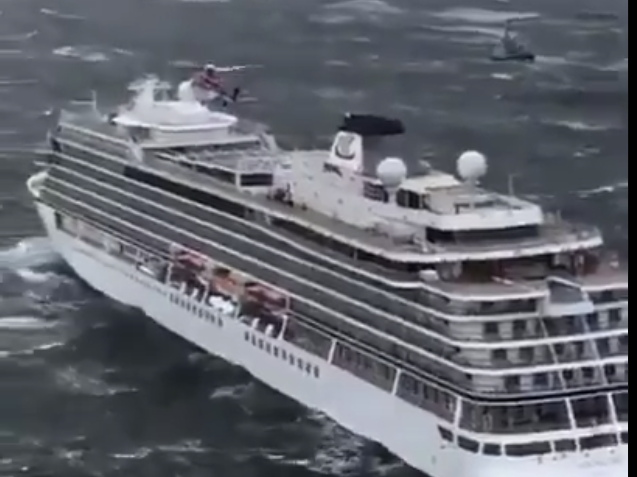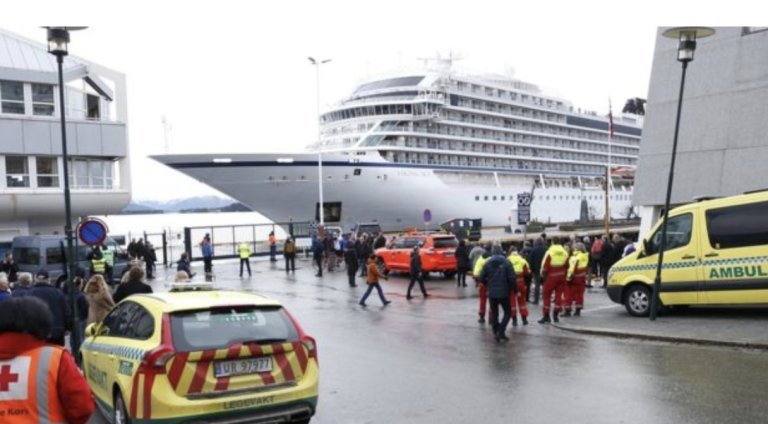A report has found that a Viking cruise ship “had the potential to develop into one of the worst disasters at sea in modern times” after it lost all propulsion and steering and drifted helplessly during a severe storm five years ago.
Viking Sky, with 1374 people aboard, came within a ship’s length of grounding in Hustadvika, Norway on March 23, 2019, after it blacked out. The engines shut down, allegedly after they sucked up air instead of sump oil.
More than 400 passengers were removed by helicopter but conditions were too bad to fully evacuate the ship.
It continued to drift and narrowly avoided being grounded as the captain manoeuvred the ship into deeper water after power was restored. As many as 900 people remained aboard, many with broken bones and injuries, while Viking Sky eventually was able to limp into port.
But the report has come under fire from the ship’s well-regarded Italian builder, who claims the findings are wrong.
Ship should never had departed
The Norwegian Safety Investigation Authority (NSIA) report agreed with the earlier finding of the Norwegian Maritime Authority (NMA) that the root cause of why Viking Sky blacked out was an insufficient level of oil in the ship’s tanks, but in disputed finding cites likely possible violations of Solas safety regulations, saying the ship should not have departed Tromso, Norway two days earlier.
Viking Sky (47,800 gross tons) entered service in 2017 as one of the class of new Fincantieri-built cruise ships for Viking’s ocean cruise line. The two-year-old cruise ship departed Tromso on March 21, 2019, and blacked out two days later.
Shipbuilder disputes report findings
Fincantiari said in a statement issued to Cruise Passenger:
“Fincantieri has already submitted and shared its stance with the Norwegian Safety Investigation Authority (NSIA). This position underlines Viking Sky’s full compliance with all class (SOLAS) requirements, dismissing the wrong assumptions made by the NSIA. It is worth noting that such wrong assumptions have been rejected also by the Norwegian Maritime Authority itself in its official statement issued on March 19, 2024.”
Both NSIA and NMA agree the root cause of the accident was an insufficient amount of lubricating oil in all the vessel’s operating diesel generators’ lubricating oil sump tanks. In the rough seas with the ship pitching and rolling, the systems lost pressure causing the cruise ship to fully black out. It took 39 minutes until both propulsion motors were operational and the ship had sufficient power to maintain between 1 and 5 knots ahead.
In its 158-page report, NSIA said operational, technical and organisational safety issues all contributed to the black out. It cited Viking, Wilhelmsen Ship Management, Fincantieri and Lloyd’s Register while calling on the International Maritime Organization (IMO), and the International Association of Classification Societies (IACS) to take action to prevent such an incident from happening again.

Design didn’t meet recommendations
NSIA says the cruise ship should never have departed Tomso, as one of its four diesel generators was not functioning. As the vessel did not have the redundancy required under the Safe Return to Port regulations, NSIA alleges it did not comply with applicable safety standards and did not meet SOLAS regulations on issues such as the lube oil sump tank design. The report added that the design also did not meet the engine manufacturer’s recommendations.
“Insufficient training likely contributed to why the black out recovery was time consuming,” the NSIA added.
NSIA issued a total of 14 safety recommendations based on its findings. They recommended Fincantieri review and strengthen the design process to ensure the lube oil sump tanks are in SOLAS compliance and that Lloyd’s Register review and strengthen its plan approval process.
The report also recommended the shipowner and operator take action to ensure compliance with SOLAS and implement systematic and holistic reviews of the oil monitoring system. They also called on IMO and IACS to include technical guidance on the rules as they relate to the oil pressure issue that occurred.
FINCANTIERI statement
Regarding the Viking Sky incident that occurred in Hustadvika, Norway, in 2019, and the subsequent allegations regarding the ship’s compliance with class requirements, Fincantieri has already submitted and shared its stance with the Norwegian Safety Investigation Authority (NSIA). This position underlines Viking Sky’s full compliance with all class (SOLAS) requirements, dismissing the wrong assumptions made by the NSIA. It is worth noting that such wrong assumptions have been rejected also by the Norwegian Maritime Authority itself in its official statement issued on March 19, 2024.
All systems aboard the vessel have been meticulously designed and commissioned in alignment with Class Regulations and, where specific regulations are absent, with the operational preferences of the shipowner. Despite this, upon being informed of the incident, Fincantieri promptly provided support to Viking both during and after the event.
It is crucial to highlight that the NSIA’s assumption misguidedly attributes the possible causes of the incident. The primary and overwhelming cause was the incorrect filling level of the oil tanks, leading to a loss of suction, as agreed also by the Norwegian Maritime Authority in its official statement above referred to.
Despite Fincantieri bearing no responsibility for the incident, the company acknowledges the report and commits to examining the recommendations put forth by the NSIA. This examination will involve collaboration with all stakeholders to assess further potential actions regarding future projects.








